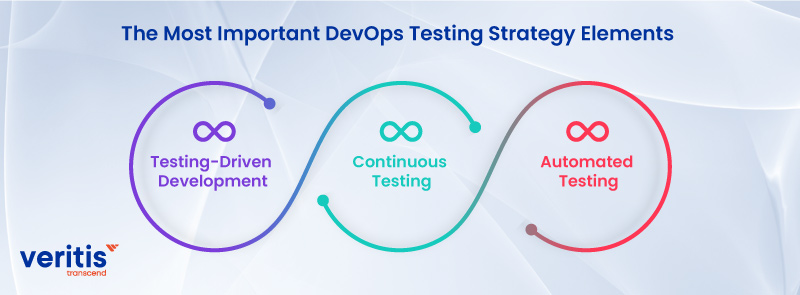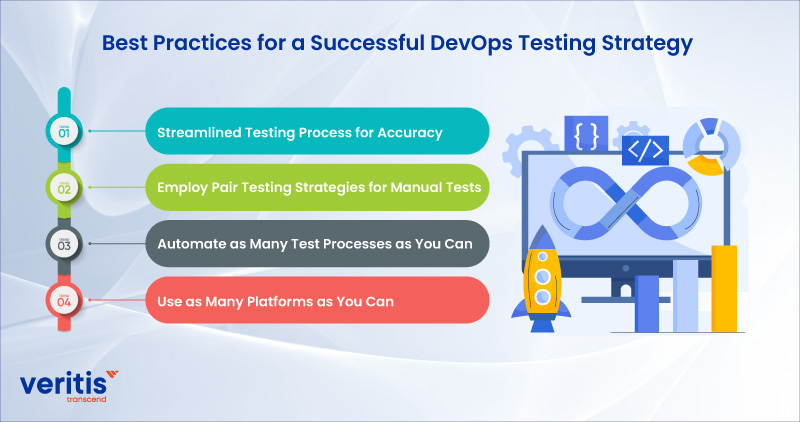
When someone uses the term DevOps, they typically mention the automation of the Infrastructure as code (IaC), build, and deployment process. However, DevOps has gained immense popularity due to the prevalence of organizational structures involving distinct departments that oversee various tasks, necessitating separate teams, individuals, and processes.
This causes inefficiencies in the development process, which DevOps motivates us to eliminate by automating processes and giving dev teams more control. However, similar bottlenecks exist with testing.
In many organizations, the testing team depends on other teams to set up the testing environment or provide test results. Moreover, many of these businesses have separate security, performance, and automated testing divisions.
Most companies of their testing team depend on alternative teams to set up the testing culture or show test results. In addition, most organizations have distinct security, performance, and automated testing divisions.
Prioritizing testing and making necessary operational adjustments to promote DevOps adoption across your organization is imperative. The only other method to increase your team’s productivity is to do that.
Testing is integral to the software development process and should be implemented across the development lifecycle to ensure a qualitative output. However, most companies practice testing as an individual process dependent on other teams for test data and environment setup. This creates a lot of hurdles in the testing process, ultimately resulting in DevOps culture bottlenecks.
So, you are experiencing delays or challenges in the software development life cycle. In that case, it’s time to reconsider your company’s testing methodologies and adopt integrated testing with development and operations activities.
The Most Important DevOps Testing Strategy Elements

Every DevOps project aims to streamline as many manual processes as possible, increase attention to people and interactions, and encourage regular communication to react rapidly to change. However, a DevOps pipeline has several barriers that impede deployment, particularly regarding timely team handoffs. Furthermore, the absence of collective responsibility for the project’s achievements or the end result’s excellence stems from a lack of shared ownership.
To overcome these obstacles, the team, including developers, testers, and operations personnel, must test as early and frequently as possible in every DevOps project. The top 3 components of a practical DevOps automated testing approach are as follows:
1) Testing-Driven Development
Building a successful DevOps pipeline involves writing unit tests for each line of code, even before it is written. Test-driven development, a crucial component of DevOps testing, enables programmers to consider the desired behavior of each software unit they’re constructing, including inputs, outputs, and error circumstances – from the beginning. In addition, such a method enables the creation of test cases first, allowing code to be developed to pass the test, making the underlying code error-free, and preventing code duplication.
2) Continuous Testing
Continuous testing in DevOps must be essential to any DevOps testing strategy if you want to execute a DevOps automated testing pipeline successfully. The shift-left testing strategy ensures that development teams find and fix errors and issues early in the development lifecycle before they escalate into more severe and expensive problems. This quick and frequent testing shortens lengthy testing cycles and improves the overall quality of the product being created, but it also decreases the likelihood that flaws will enter production.
3) Automated Testing
Test automation is a crucial component of a successful DevOps testing approach. Your code is continuously merged into a shared repository due to the Continuous Integration used to update the applications in your DevOps test automation pipeline. While giving teams immediate feedback on the functionality and quality of applications, test automation removes the risk associated with continuous integration. In addition, test automation lowers the likelihood that errors will be added to the finished product by automating testing for every new iteration of the code.
Useful link: Derive ‘ROI’ from ‘DevOps’: An Overview of Performance and Metrics
3 Ways to Build an Effective DevOps Testing Culture:
Creating an influential DevOps automated testing culture is essential for organizations aiming to enhance software quality, accelerate development cycles, and improve collaboration between development and operations teams. Here are three strategies to cultivate such a culture:
1) Laying the Right Foundation
The initial challenge is finding the basis for changing this unfriendly DevOps testing culture. For this, you will first have to enhance the skill set of your Quality Assurance (QA) team. The QA testing team should perform automated testing and understand how the application is built and how the testing process can add value to its functionality.
Moreover, testers need to know about and understand processes such as continuous integration and Infrastructure-as-Code (IAC).
To enhance the workforce’s skillset, you can train your testers or get vendors to replace manual testers with engineers. While it is still manageable with manual testers on board, hiring testers with the relevant skillset is advisable.
2) Redefine the Way Your Team Works
DevOps methodology is a process that is focused on minimizing inconsistencies associated with dependency, repetition, and delays through the culture of self-sufficiency.
Test automation in DevOps paves the way for timely feedback and boosts process efficiency, underlining its significance in the DevOps culture environment. Testers should be responsible for creating and supporting automation from the beginning and ideally strive to be self-reliant to achieve desired DevOps test automation benefits.
3) Contribute to Innovation Through Empowerment
Giving your team the leverage to learn and experiment within their work hours helps them identify better work DevOps practices and enhance their technical skillset. In that case, you, as a leader, must also take the initiative to help people innovate.
Create time during regular work hours where employees can invest in themselves and improve their work. Also, instead of only rewarding persons per project, motivate the efforts of employees who learn new skills and leverage them to achieve process efficiency.
Useful link: How to Implement Artificial Intelligence in DevOps Transformation?
Best Practices for a Successful DevOps Testing Strategy

Planning for a successful DevOps testing tools strategy needs to be revised. The effectiveness of this strategy can be severely hampered by a poor understanding of recommended practices for its implementation.
1) Streamlined Testing Process for Accuracy
Typically, a combination of scripting and programming languages is used for testing. Non-technical stakeholders may only sometimes be able to comprehend this. All stakeholders can become more aligned using a framework like Gherkin, which QA teams can use to explain testing to non-technical audiences.
2) Employ Pair Testing Strategies for Manual Tests
A certain number of manual tests must always be run even though the best DevOps testing tools strategy fully uses automated testing’s power. Two testers work side by side, running the test while the other checks the outcomes. Any two DevOps team members can form a pair, particularly when developers are analyzing tests run to address code errors more effectively.
3) Automate as Many Test Processes as You Can
Resolving problems is essential for the effective functioning of DevOps principles during development. For instance, developers can enhance efficiency, save resources, and expedite regression test suites by automating visual tests and implementing parallel testing techniques. This also enables them to fix any bugs before they impact the application.
4) Use as Many Platforms as You Can
Today, many devices are used to deploy mobile and web apps. Therefore, regularly testing the application on all anticipated devices is crucial to achieving optimum performance. Unfortunately, simulators and emulators fall short in their attempts to simulate real-world program performance. Therefore, accurate device testing is essential to ensuring that the DevOps testing tools strategy is deployed and operates as intended.
Conclusion
Embracing collaboration, automation, and a culture of continuous testing in DevOps improvement lays the foundation for a thriving DevOps testing culture. This multifaceted approach enables faster and more reliable software releases while fostering a shared responsibility for quality across teams. Ultimately, it improves customer satisfaction and contributes to overall business success.
A successful DevOps culture implementation moves beyond automating SDLC and demands a change in overall organizational structure, operating teams, and work culture. It means having sufficient resources for each process and decreasing the dependency on enterprise IT teams for operations and security testing activities. Testing teams impact the way features are deployed to production. Ensure to make them part of this cultural DevOps transformation.
Veritis, the Stevie Award winner, delivers comprehensive solutions for DevOps testing, emphasizing collaboration, automation, and a culture of continuous improvement. We understand the importance of organizational change, sufficient resources, and reducing dependency on enterprise IT teams. By involving testing teams and fostering shared responsibility for the quality, Veritis enables faster and more reliable software releases, improving customer satisfaction and overall business success.
Got Questions? Schedule A Call
Also Read:
- DevOps outsourcing: Things to Know About Before Getting Started
- DevOps Implementation: 4 Steps to Success
- Future of DevOps: Top DevOps Trends in 2023 and Beyond
- Why Continuous Testing is Significant for Continuous Integration (CI)/Continuous Delivery (CD)
- Explained: Pros and Cons of DevOps Methodology and its Principles
- Why Should You Adopt DevOps and What are the Benefits it Offers?